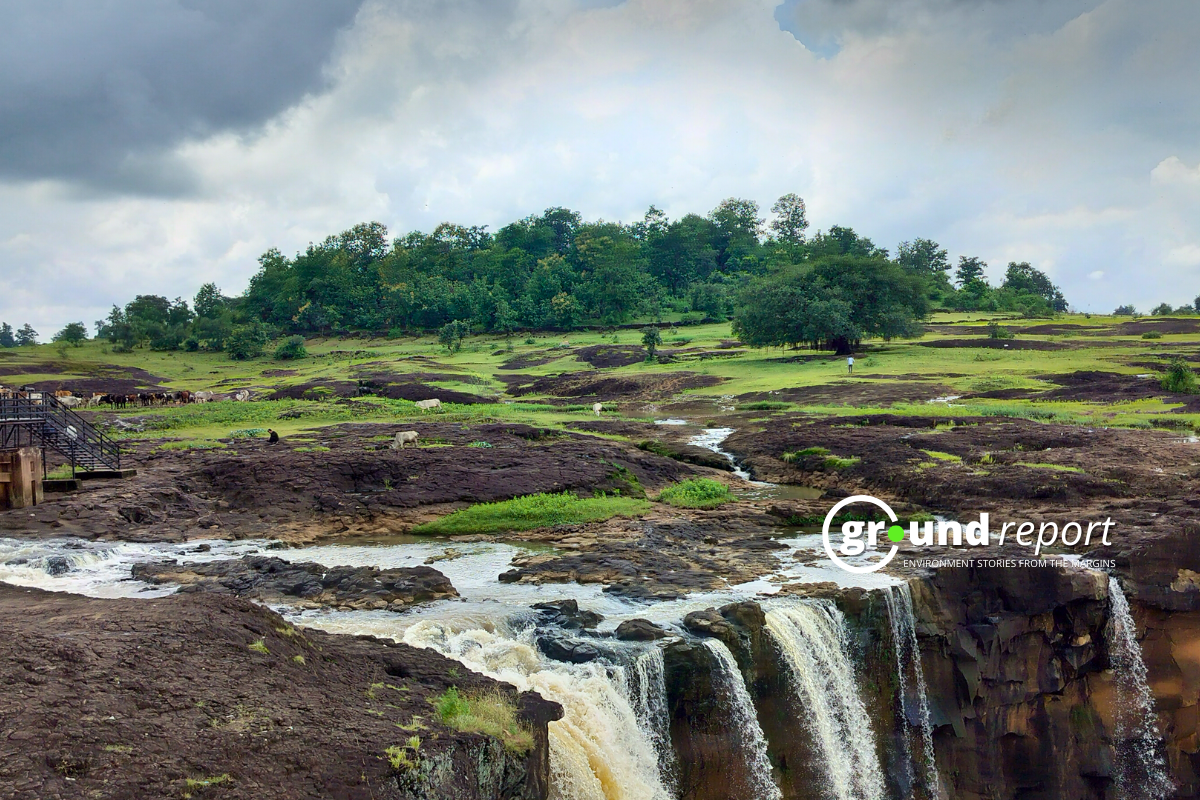On July 19th, 2024, seven people, including a nine-year-old boy, died from lightning strikes in Madhya Pradesh within 24 hours, highlighting the state’s vulnerability. In the same incident(s), two women–Gura Bai (36) and Geeta Bai (35)– were struck in Bangaria-Chakk village of Ashok Nagar district, and three others were injured. In Chhatarpur district, Ravindar Raikwar, a Class 3 student, was fatally struck while playing on a school ground, and a farmer also died in the same district.
Madhya Pradesh India’s lightning hotspot
According to the report by the Climate Resilient Observing Systems Promotion Council (CROPC) and the India Meteorological Department (IMD), Madhya Pradesh recorded 987,095 lightning flashes in 2022-23– the country’s highest. Saurabh Kumar, Deputy Director of the State Disaster Management Authority told Ground Report,
“Lightning is a natural phenomenon, and due to the unique atmospheric conditions in Madhya Pradesh— including a high prevalence of water bodies, the region experiences a significant number of lightning strikes. While we cannot prevent lightning, our focus is on safeguarding our communities.”
The severity of the situation is evident when looking at the long-term data. Over the past six years, Madhya Pradesh has witnessed an average of 442 lightning-related deaths annually, peaking at 496 fatalities in both 2021 and 2022. In 2020, the state recorded 429 deaths, followed by 400 in 2019, 381 in 2018, and 452 in 2017.
The state has the highest 20-year average of lightning deaths (2001-2020) at 315.45, according to CROPC data from 2022. In the same period, floods and droughts have caused fewer deaths compared to lightning strikes. As per the National Crime Records Bureau (NCRB) Report, 2022, out of 8,060 deaths caused by natural forces, 2,887 were due to lightning, accounting for 35.8%.
Data from the National Crime Records Bureau (NCRB) shows that in 2022, lightning caused 496 deaths, compared to 15 deaths from floods, 27 from heat exposure, and 24 from cold exposure. This pattern is consistent over the years, with lightning fatalities far exceeding those from other hazards: in 2021, there were 496 lightning deaths versus 12 from floods, 2 from heat exposure, and 22 from cold exposure; and in 2020, there were 429 lightning deaths compared to 11 from floods, 7 from heat exposure, and 19 from cold exposure.
On the other hand, there’s a lag in official recognition and response to this growing threat. The Madhya Pradesh State Disaster Management Authority’s website doesn’t list lightning as a major natural calamity, rather focuses on earthquakes, floods, landslides, heatwaves, and hailstorms.
Officials question NCRB’s lightning death data
While NCRB reports high lightning-related deaths, state officials question these figures. Saurabh Kumar, Deputy Director of the State Disaster Management Authority (SDMA), said,
“Our commitment to minimizing the loss of life is demonstrated through our meticulous approach to data collection. However, we face challenges with the data from the NCRB, where electric shock incidents are sometimes wrongly classified as lightning-related deaths. This misclassification leads to discrepancies in the data, which we are actively working to correct.”
On the other hand, Professor Manoranjan Mishra of Fakir Mohan University, who has conducted extensive research on lightning in India, particularly in Odisha, emphasizes the underreporting of official data. He stated,
“The NCRB’s report on lightning-related deaths generally shows lower numbers compared to the actual figures.” He further explained, “In Odisha, for example, the Special Relief Commissioner’s (SRC) annual report indicates a higher number of deaths compared to the NCRB data because it also includes deaths reported for compensation purposes. Neither the IMD nor the NCRB captures the full extent of these incidents, as some cases go unreported. However, when families file for compensation, the true number of deaths due to lightning strikes becomes clearer.”
Experts urge better warnings, education for lightning safety
According to a study, Madhya Pradesh has high lightning fatality rates due to its densely populated areas. The flat terrain usually sees fewer lightning strikes compared to hilly areas, but the high population density, with about 236 people per square kilometre, increases the likelihood of casualties.

Dr. Sunita Verma, Associate Professor at the Institute of Environment and Sustainable Development at Banaras Hindu University and author of “The major lightning regions and associated casualties over India,” explains,
“The high casualties in Madhya Pradesh are due to the lack of an effective early warning system and unsafe sheltering practices among the rural populace, particularly farmers. Most fatalities occur when individuals seek refuge under trees during thunderstorms, not realizing the increased risk.”
Dr. Verma explains,
“Madhya Pradesh experiences significant cumulonimbus cloud formation, prone to lightning activity… The absence of regular warning systems and public awareness programs contributes to the high number of lightning-related deaths. The government needs robust mitigation strategies, including timely warnings and accessible educational campaigns, especially in rural and vulnerable areas.”
Saurabh Kumar agreed that as part of the mitigation strategy, it is critical to alert the population ahead of a lightning strike. He added, “We do this by using timely information from the India Meteorological Department (IMD) and sharing it with local officials in the district. This ensures that district authorities and field officers are informed in advance, enabling them to take precautions.”

He further added, “To ensure the safety of our population during lightning strikes, we’ve implemented an alert system including SMS alerts and the Common Alerting Protocol (CAP). This system sends real-time notifications to people’s mobile phones, ensuring they receive critical warnings promptly.” When asked, whether the lightning alert system is saving lives, the official did not confirm or deny its effectiveness.
Climate Change & pollution increases lightning frequency
The impact of climate change on lightning frequency is well established. A 2014 US study found that for every 1°Celsius rise in global air temperature, there is a 12% increase in lightning strikes. By 2100, there could be a 50% rise in lightning strikes, assuming a 4°C temperature rise. With rising global temperatures, the trend is worrying for regions like Madhya Pradesh already grappling with high lightning activity, with nearly 1 million lightning strikes in 2022-23.
The link between climate change and increased lightning is multifaceted. Rising temperatures lead to more atmospheric instability and moisture, contributing to thunderstorm formation. Warmer temperatures provide more heat energy to fuel storm clouds, making them more energetic and prone to lightning. A warmer atmosphere with higher moisture leads to more vigorous thunderstorms and increased lightning.
Pollution too increases lightning frequency. Research shows aerosol pollution influences lightning properties. Urban areas, especially downwind, have increased lightning frequencies due to urban thermodynamics, surface properties, and aerosol pollution. Rising pollution in Madhya Pradesh may worsen the problem. A 37% increase in countrywide lightning is partly due to pollution.
States demand lightning classification; centre rejects
The lack of recognition extends to the national level. In February 2024, Biju Janata Dal (BJD) MP Manas Ranjan Mangaraj urged the Central Government to declare lightning as a natural disaster during a Zero Hour session in the Rajya Sabha. However, the Union government opposed this, arguing that lightning-related deaths can be prevented through education and awareness. States like Bihar, Madhya Pradesh, and West Bengal have demanded that lightning-related deaths be covered as a natural disaster, entitling victims to compensation from the State Disaster Response Fund (SDRF).

As per the India Meteorology Department (IMD), around 2,500 people die due to lightning strikes in India annually.
The Ministry of Earth Sciences, IMD, and the Pune-based Indian Institute of Tropical Meteorology (IITM) aim to reduce lightning-related deaths. One initiative is the Damini App, which sends warnings before lightning strikes, but the lead time is only 30-40 minutes.
Saurabh added,
“Locally, we emphasize extensive community awareness campaigns and have mandated the use of the Damini app among all field officials, ensuring officials and the public are well-prepared and informed about the risks of lightning, enhancing their ability to respond effectively.” *
On the other hand, experts argue that the warning period is often too short for people to take protective measures. Some experts suggest installing lightning catchers and increasing public awareness.
Innovative global solutions
Experts from various countries have proposed other solutions. Chandima Gomes, a professor of high-voltage engineering at the University of Witwatersrand in South Africa, suggests using repurposed materials like cargo containers as “safe shelters.” Some countries have effective public awareness campaigns and slogans like “When Thunders Roars, Go Indoors!’ have reduced lightning deaths.
Ground Report previously reported on the impact of lightning strikes in Jammu & Kashmir, Odisha, Uttar Pradesh and West Bengal, highlighting the administration’s inaction.
Lightning strikes in Madhya Pradesh pose a growing challenge at the intersection of climate change, public safety, and disaster management. The state continues to bear the brunt of this natural phenomenon, and the coming years will be crucial in determining measures to reduce the toll of this silent but deadly threat.
*Ground Report filed an RTI request to obtain details on the mitigation strategies, adaptation solutions, and compensation measures implemented by the Madhya Pradesh state government. We will update our story once we receive a response.
Keep Reading
Lightning strikes leave two children without their mother in West Bengal
Lightning alerts ‘not enough,’ to save lives, say experts; rural areas still at risk
Lightning strikes in Odisha: Do palm trees really protect against lightning strikes?
In Jammu, lightning strikes kill livestock, compensation not adequate say shepherds
Indigenous communities in J&K struggle with increasing lightning risks to livelihoods
Support us to keep independent environmental journalism alive in India.
Follow Ground Report on X, Instagram and Facebook for environmental and underreported stories from the margins. Give us feedback on our email id greport2018@gmail.com.
Don’t forget to Subscribe to our weekly newsletter, Join our community on WhatsApp, and Follow our YouTube Channel for video stories.






